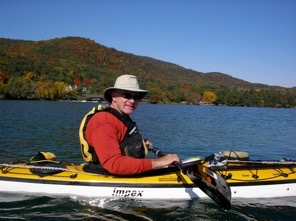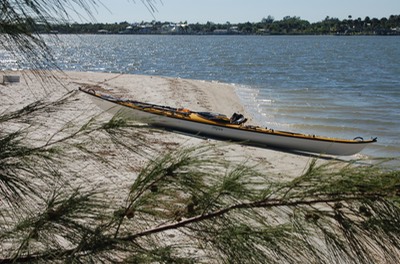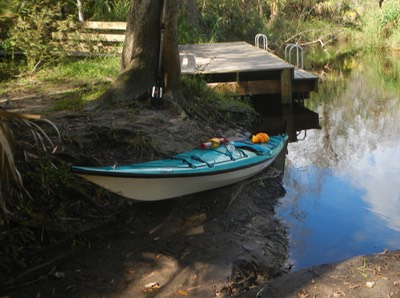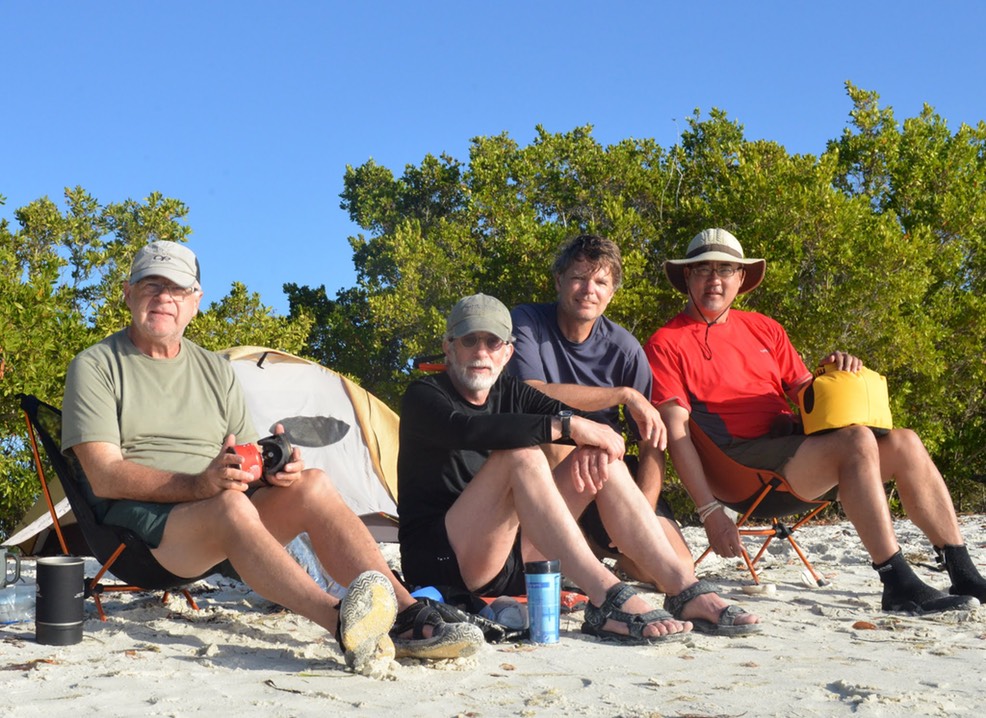
L-R: Don, Bruce, Kaare, Tom on Pavilion Key (Photo by K. Christian)
Planning and Logistics
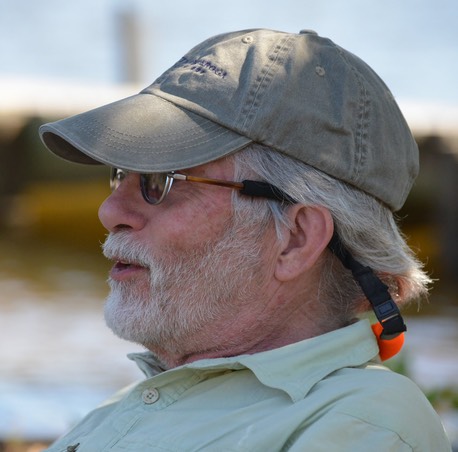
The planning for this trip really started toward the end of our summer adventure on the Saguenay Fjord in Quebec. Then it lay dormant for a while, resurfacing around Thanksgiving 2013. We put out a call for interested parties to all the Saguenay veterans. Six, including me, responded; Bruce
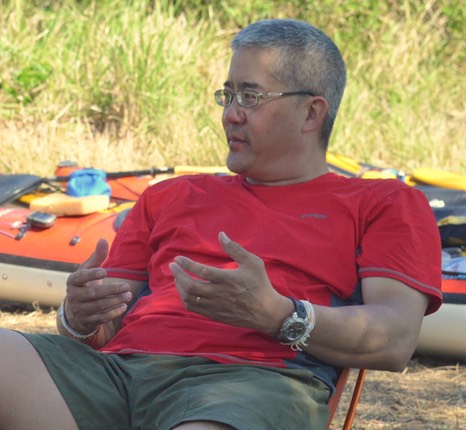
Romanchak from the Albany area of New York State, Kaare Christian and his wife, Robin Raskin from Manhattan, Tom Doo from the Princeton, New Jersey area and Alan Lovegren, currently from Ft. Meyers, Florida, and myself. In the end, Robin had to drop out because of work commitments, and Alan for health reasons, leaving four guys. This is a good number of paddlers to have in a group; not so big that campsites will be unavailable, but big enough to be safe.
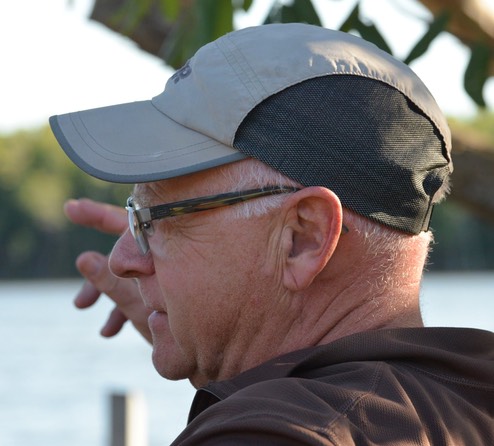
Bruce coordinated planning on the northern end. This included confirming dates, arranging transportation for paddlers, their boats and gear, and finding lodging in Florida. My job was to coordinate the actual trip planning; dates, routes, National Park contacts and procedures, securing permits, etc.
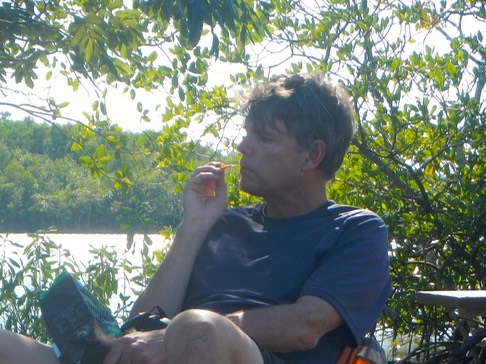
We had five days for paddling and four nights for camping available to us. The route we agreed on took us along the Everglades Wilderness Trail for two days, then out into the Gulf Islands (Florida’s 10,000 Islands) for three days. We would stay on one of the islands for two nights. (Top three photos by C. Christian)

Our Route:
Day 1: National Park HQ to the Lopez River Site (about 8 miles)
Day 2: Lopez River to the Watson Place (about 11 miles)
Day 3: The Watson Place to Pavilion Key by way of Mormon Key (about 8.5 miles)
Day 4: Day paddle from Pavilion Key, stay a second night
Day 5: Pavilion Key to National Park HQ by way of Smallwood’s Store (about 14 miles)

Actual Distances and Paddling Conditions:
Day 1: National Park HQ to the Lopez River Site
- Miles Paddled: 7.8
- Moving Time: 2h 38m
- Average Speed: 2.9 mph
- Conditions: Easy paddling, mostly flat water. Boats very heavy with gear and water.
Day 2: Lopez River to the Watson Place
- Miles Paddled: 10.3
- Moving Time: 3h 54m
- Average Speed: 2.6 mph
- Conditions: Because we were impatient and left before low tide, we paddled against an outgoing tide up the Lopez River and against an incoming tide down the Chatham River. This ,combined with wind and wave action on the three big open bays we crossed (Sunday Bay, Oyster Bay and Huston Bay), slowed us down.
Day 3: The Watson Place to Pavilion Key by way of Mormon Key
- Miles Paddled: 11.2
- Moving Time: 3h 31m
- Average Speed: 3.2 mph
- Conditions: Conditions on the Chatham river were great; an outgoing tide and a light breeze to keep us cool. The Gulf was much the same. It was a glorious day for paddling.
Day 4: Day paddle from Pavilion Key: We paddled to Rabbit Key
- Miles Paddled: 8.3
- Moving Time: 3h 5m
- Average Speed: 2.7 mph
- Conditions: A strong breeze developed on this day. We spent a fair amount of time at Rabbit Key before heading back to Pavilion. We hopscotched behind and among the mangrove islands to limit our exposure to wind and waves.
Day 5: Pavilion Key to National Park HQ by way of Smallwood’s Store
- Miles Paddled: 13.5
- Moving Time: 3h 54m
- Average Speed: 3.5 mph
- Conditions: Conditions were difficult on open water. Strong winds generated two foot waves that were very close together where the wind had a long fetch. However, we had shelter in the passes most of the way.

Planning:
There are many resources available for planning. The best of these is the National Parks Service Wilderness Trip Planner for Everglades National Park. It can be found at this URL: Wilderness Trip Planner
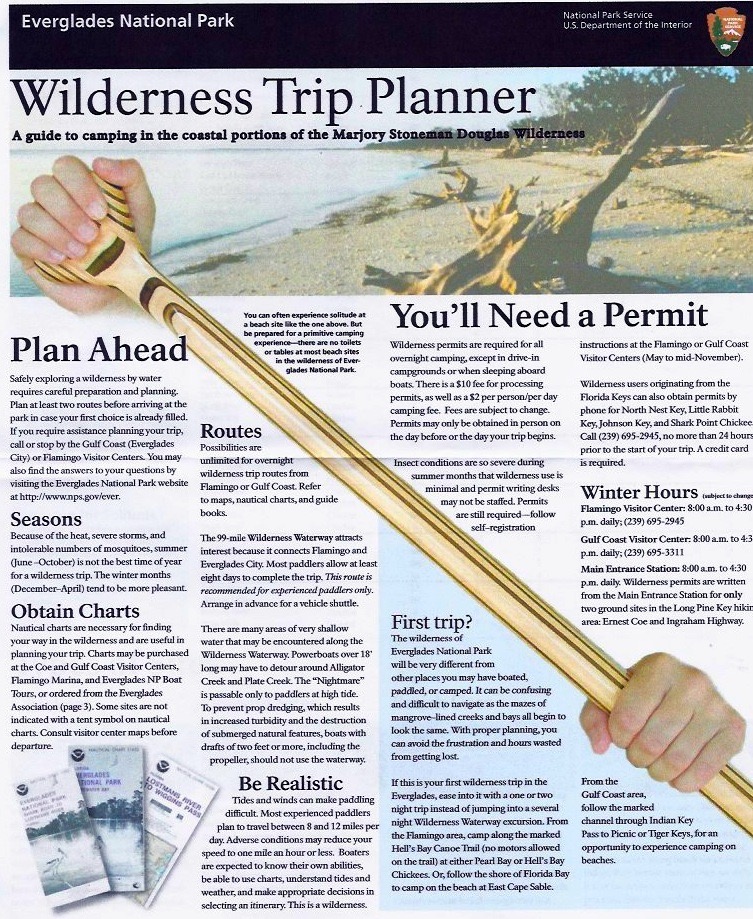
Two books are also useful: Paddling the Everglades Wilderness Waterway by Grenzen and Sullivan, and A Paddlers Guide to Everglades National Park by Malloy. These books can be found at Amazon. Maps can be purchased through Friends of the Park, and a new, waterproof map can be purchased at the park office.
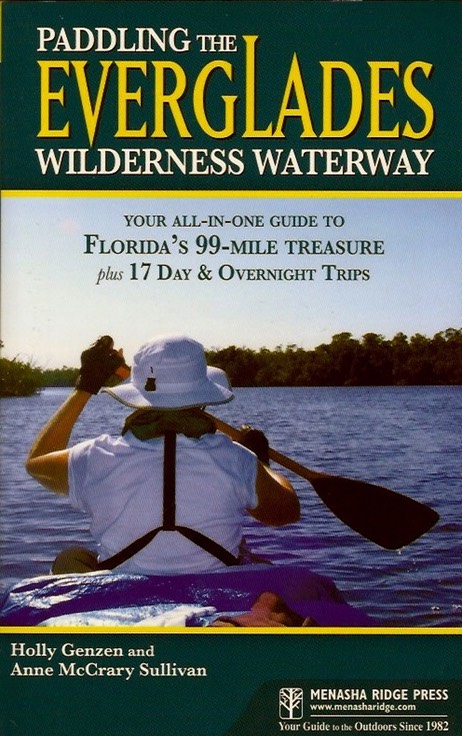
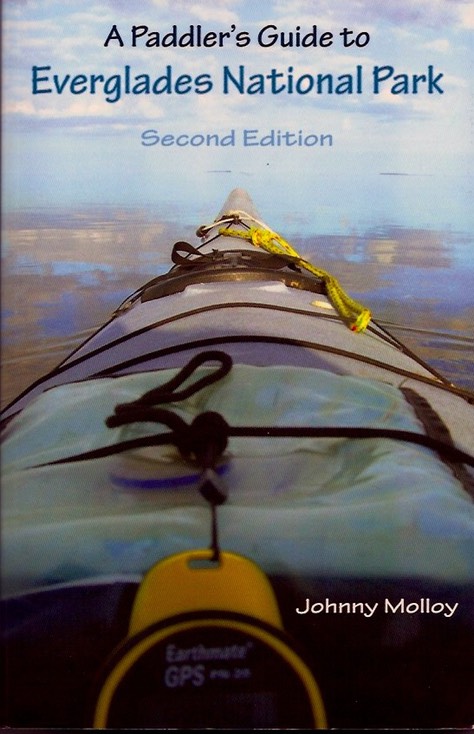

Preparation:
Preparing for a trip like this is part of the fun. It is a real challenge to see if you can think through the various aspects of your trip and plan appropriately.
- What kind of clothes will I need?
- Will it be warm or cold? Wet or dry? Buggy or not?
- What kind of tent is appropriate? Will it fit easily in my boat?
- Which sleeping bag is appropriate? The summer weight bag or the three season bag?
- How about a pillow and a sleeping pad?
- How much water will I need? Can I resupply water along the way? Or must I carry all the water I will need?
- How many breakfasts, lunches and dinners will I need to plan for?
- What will the menu be?
- Do I have the stoves and cooking gear to prepare my meals?
- Will I need permits to camp or can I “commando” camp along the way?
- What kind of safety gear will I need to bring? Do I need a first aid kit?
- Will there be cell service where I’m paddling? How will I recharge my phone?
- Do I need to carry a VHF radio? What about a SPOT or PLB?
- How about a first aid kit?
- Will I be able to get all of this gear in my boat?
These are just some of the questions you should be asking yourself as you prepare for a multi-day, unsupported paddling trip. To help me think these things through, I have developed a checklist. This checklist is still evolving but I have included it here as a PDF document that you can download and use.

Logistics For This Trip:
- Water: There is no access to water on the Water Trail or the keys. The NPS advises campers to pack one gallon of water per person, per day. That equals 5 gallons for each of us (about 40 pounds of water in each boat).
- Food: Unlike our last trip where we had access to plenty of fresh water and prepared group meals, this time we elected to go the Mountain House, freeze dried meals route. This took less space in the boats. We only needed a Jetboil stove and no additional cooking or clean-up gear, again saving space in the boats. And each meal used only 16 ounces of water.
- Personal Hygiene: You can’t really spare water to wash or shave. Most folks bring the largest personal wipes they can find and wipe down with these. You can take a sea bath, but you will probably find you feel sticky from the salt in the water rather than clean when you are done. We also pack anti-bacterial hand cleaner. The one thing we do use water for is brushing our teeth.

Some of my gear ready for repacking in my boat. (Photo by K. Christian)
- Toileting: All of out sites had porta-potties with toilet paper, but not all sites do. Where there is no toileting facility, you need to have camp toilet paper, a hand trowel to bury your feces, and a ziplock bag to carry out your used paper. I also carry a lighter to burn and burry the paper if I can’t carry it out. If you use baby wipes you must place them in a container in the porta-potty, not in the toilet. If there is no porta-potty you must pack these out with you. They will not degrade quickly enough in the ground.
- Bugs: You have to expect to find bugs in the Everglades. You know how bothered by mosquitos and no-see-ums you are, so plan accordingly. They don’t really bother me too much. Bring bug spray (I don’t use Deet. I use Picardin which I find to be very effective) and/or a bug suit.
- Chairs: Five days is a long time to sit on the ground or in your tent with no back support. At least bring a Crazy Creek chair. Mine fits on the floor of my kayak in front of my seat. One of the new REI camp chairs is even better and it will fit in my day hatch!
- Permits: You need a primitive camping permit to camp in Everglades National Park. The permits are site specific and can only be reserved in person no earlier than the day before you expect to launch. I went to Everglades City a day early and stayed in a motel so that I could be at the park office by 6 am. The office opens at 8 am but I had been told that the lines start to form early. Not on this day. Two other people looking for permits showed up at 7:45 am. Even though I had alternate sites identified if we needed them, I easily got the sites we wanted.
- Tides: Current tide information is available at the park office when you register. You do need to pay attention to tides to make your travel easier.
- Carry In - Carry Out: The Park Service is serious about carry in - carry out. Before they give you your permit they read the list of rules, ask if there are questions and have you sign that you have reviewed and understand them. That’s serious business. I brought a dry bag with two two gallon zip-lock bags inside. All of my garbage went into this dry bag and was kept in my hatch to keep critters away.
- Packing - What to Take: I use a checklist to help me remember everything I need and keep me focused. That packing list can be found by clicking here: Gear List. You are free to use or modify this list, or you may want to make your own.
- Loading Your Boat: If you haven't done a lot of tripping before, I recommend that after you assemble the gear you think you want to take, load it in your boat to see if it fits. Then decide what you can leave behind and what is essential to take BEFORE you get to your launch site.
- Need Some Help From Pros? If you are not comfortable taking on an unsupported wilderness trip in the Everglades, I can suggest an outfitter whose work focuses on the Glades and Ten Thousand Islands. I have never engaged the services of these guys, but I have watched them work with clients and seen their gear over several years. They are real pros. Here are their business cards.
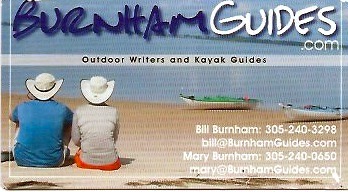
The Outfitter
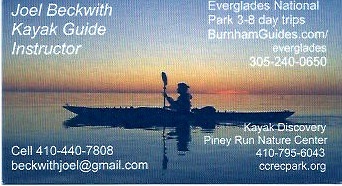
Joel specializes in Everglades trips.

After paddling the Glades and Islands, read this book!
We stayed at the Watson Place. I found it to be lovely and serene. And I imaging that Ed Watson and his family thought so too, at least some of the time. What I never thought about was how that silence day after day could slowly drive you crazy. This was mentioned over and over in the book, Killing Mr. Watson. Another thing I had no inkling of was that four people died where we were sleeping. One, a young indian girl disowned by her family, hung herself in the boat house after being repeatedly raped by L. Cox, Watson's Overseer. Two other workers on the site, Green the hog tender and his six foot tall, three hundred pound wood splitting amazon woman got into a fight with Cox over the incident. In a drunken rage, he killed them both, gutted them and filled their bodies with weights, dumping them in the Chatham River. It was only by chance that their bodies were found. A fourth murder occurred when another workman returned. Cox killed him too, or so it seems. The only eye witness, a negro worker who escaped, first laid the blame on Watson, then on Cox. Watson was killed when the folks at Chocoloskee tried to arrest him. He was buried on Rabbit Key, then moved to Ft. Meyers. We stopped at Rabbit Key for lunch.
So many places that are mentioned in the book are familiar because we either visited there or passed nearby. Panther Key was settled by G. Lopez, the same Lopez who gave his name to the Lopez River and our homestead campsite. Lopez named the key Panther, after goats he was keeping there were killed by a panther that swam out to get them. I mentioned in a previous report how Pavilion Key got its name. Pavilion had a thriving clamming industry. Several people wanting to escape the ruckus on Pavilion went to Little Pavilion Key to stay, another place we visited.
Beyond the familiar locations, this is an interesting historical novel with fictionalized accounts by the various characters involved, based on what historical data the author could find. I really enjoyed the uneducated Cracker language used in the monologues. Once you have paddled in this area you should read the book. It will bring this wilderness to life!
Click here to read my review of "Killing Mister Watson"
